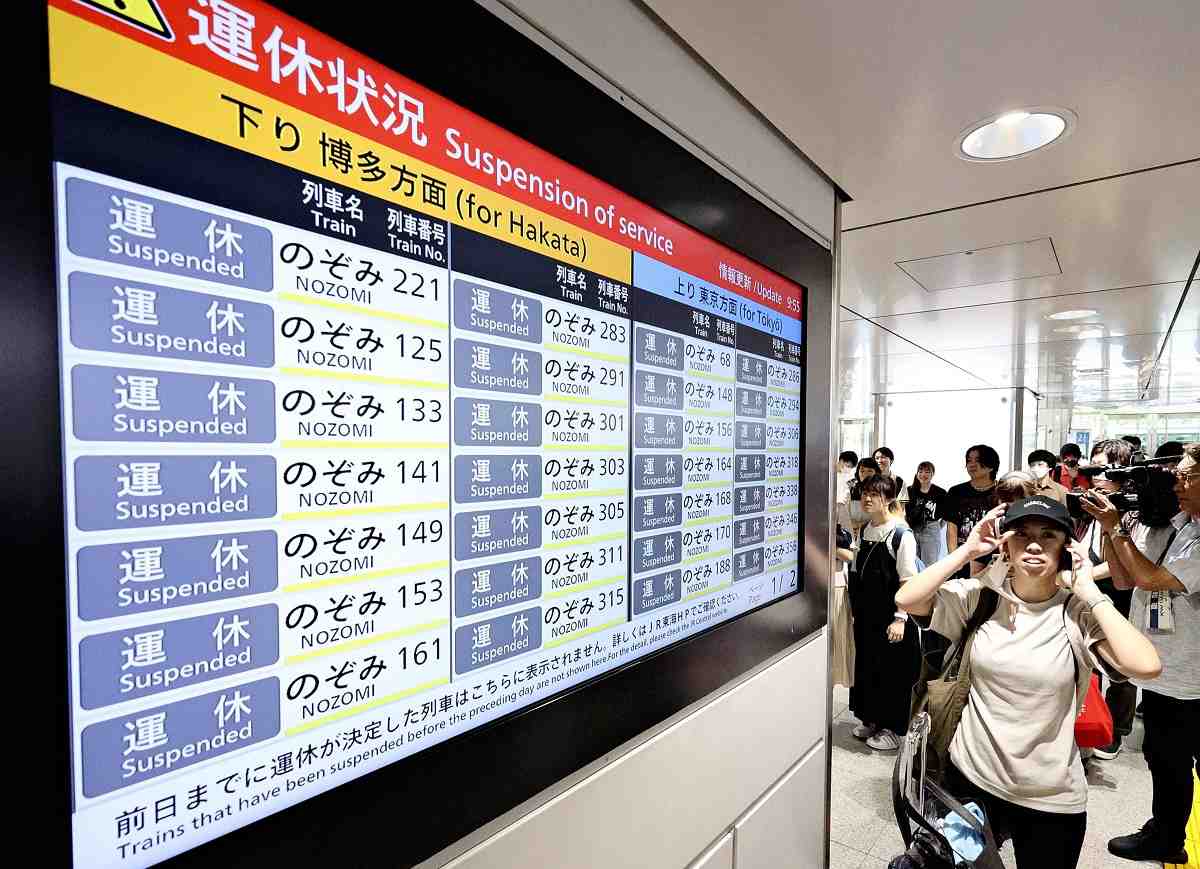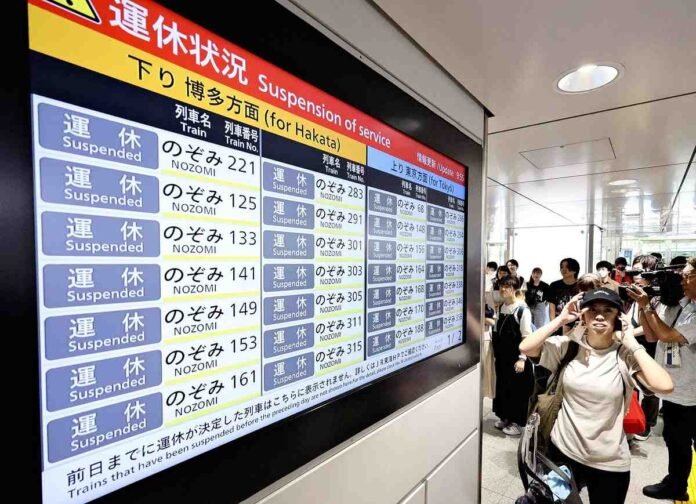To accommodate two Shinkansen trains on one platform, one stops about 50 meters in front of the other during an exercise at JR Shinagawa Station on May 22.
11:54 JST, June 19, 2024
Last summer, heavy rains caused multiple disruptions to Tokaido Shinkansen schedules, stranding passengers aboard trains and causing confusion.
Looking back on the incidents, Central Japan Railway Co. (JR Tokai) to review the method of releasing information on its operation during heavy rains and also take measures regarding railway structures such as railway embankments. Officials urge users to check the latest operating information when heavy rain is forecast.
2 trains on one platform
At around 12:20 am on May 22, a Tokaido Shinkansen train slowly came to a stop at Platform No. 24 at JR Shinagawa Station after the departure of the last train. About 50 meters away, on the same platform, was another Shinkansen that had come in earlier.
An exercise was held that day with the idea that train traffic had been halted for an extended period of time due to heavy rain. The train stopped in front of Shinagawa station and was driven to the station where passengers could alight. Two trains were accommodated on a platform where only one would normally stop, and officials controlled the timing for opening the exit gates.
“We would like to apply what we learned from the training in our manuals and training, such as the procedure for disembarking passengers through the exit gates even if the positioning of the gates and the train doors are not aligned,” said Masafumi Kondo , head of the transportation sales department of JR Tokai’s Shinkansen Operations Division.
In June 2023, the Tokaido Shinkansen was temporarily suspended due to heavy rainfall caused by the seasonal rain front. Tokyo station was packed with stranded passengers, and dozens of high school students there on a school trip said they felt unwell.
In August, the day after a planned suspension of services as a precaution against an approaching typhoon, rain gauges in Shizuoka Prefecture showed figures above the legal limit. This caused some parts of the line to be suspended. Subsequently, Shinkansen service suspensions were extended to the section between Tokyo and Hakata, forcing some trains to stop between stations for extended periods of time. On August 16 and 17, more than 200 trains were canceled and more than 400 trains were delayed on the Tokaido Shinkansen line alone, affecting approximately 500,000 passengers.
Improvements for the timetable app

Information about Shinkansen train cancellations will be displayed on a notice board at JR Tokyo Station on August 17, 2023.
One of the lessons JR Tokai learned from these experiences last summer was the need to provide faster and more accurate information.
In the past, when there was a possibility of service delays or cancellations due to heavy rain or other factors, the company would notify passengers after an alternate service plan was established. But it has changed operating procedures to announce the possibility of service suspensions or other issues at an earlier stage, before deciding on the service plan. On May 28 this year, when heavy rain clouds were suspected to appear, the company quickly announced the possibility of delays or cancellations.
The company also began to increase the frequency of announcements on social media and other media after suspending operations, even if the situation remained unchanged. At the end of last year, the Shinkansen timetable app was also upgraded. Previously, it mainly used a website with information about Shinkansen operations as its main tool to disseminate information. Shinkansen’s timetable made it possible for users to check its operational status in real time.
Placing sensors at 18 locations
The company also began taking measures to protect railway embankments from rainfall.
According to JR Tokai, 44% of all Tokaido Shinkansen lines run on an embankment. This percentage is the highest of all Shinkansen lines in the country. If rainwater seeps into the dike, the soil becomes loose and the risk of collapse increases. It can cause track deformations and, in the worst case, lead to train derailments. To prevent rainwater from entering the dikes, the railway company has taken preventive measures, such as covering the surface of the dike with concrete and laying pipes to drain the water.
In June, the company began continuously monitoring the water in the soil during rainfall, to gain a detailed understanding of its distribution. Sensors that monitor water distribution have been installed in dikes at 18 locations in Shizuoka Prefecture, including Shizuoka City. Holes were also made in the ground to observe the rise in groundwater levels at two nearby locations. The company plans to collect the results after tracking the data for about two years. After evaluating the performance of the dikes at individual locations, it will carry out construction and take appropriate countermeasures.
“We want to improve the safety of our service by creating appropriate operational regulations in the event of heavy rain,” said JR Tokai President Shunsuke Niwa.



